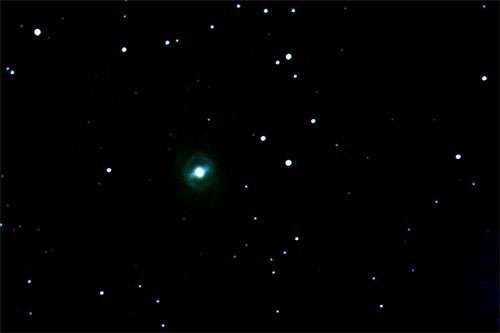

I bought his some 12 years ago second hand. While using it for visual astronomy it was ok, but as I progressed I wanted to see more than just faint patches which could only be seen with averted vision. This took me into the realm of prime focus astrophotography.
The set up is standard with a small SkyWatcher mounted on top of the LX200 tube. An Orion SSDSI CCD camera is attached to the SkyWatcher so that it can be used for guiding, usually using AstroArt for guiding control. A standard Canon 350D is then attached to the optical tube, with or without a focal reducer.
I found that with the camera attached that the image shift was less significant than when using an ordinary eyepiece, presumably because the focusing mechanism is in a less worn region.
Fortunately the motors on this telescope still work well, although the software is very out of date. I was amazed to find that the controller only goes up to the year 1999, so to breath life into the goto functions I connected it to a computer running Starry Night Pro version 5. This combination works amazingly well, particularly when the telescope has been accurately polar aligned. I run the telescope control software and autoguiding from one computer and the camera control from another computer.
Down to basics: I leave the tripod in the garden with the equatorial wedge on it all the time, and bring the telescope with all the attached equipment into the house in one go. I have the tripod legs fairly well extended, this gives it a wider base and is more stable. The tripod and wedge are covered over when not in use to protect it somewhat from the weather, however, the cover does have to be tied down well to the tripod otherwise it can blow over in a strong wind....it did happen much to my surprise. The alignment of the tripod is then retained and positioning of the telescope on the tripod is surprisingly reproducible. This is important, because I found it takes a very long time to align this telescope using the drift method....you are never sure if the drift is true or if the mirror has shifted. The refinements over several night make the alignment very accurate, which helps the autoguiding tremendously. The PEC can then be trained using the autoguider and you are ready to go.
I only image objects in easterly direction, and up to about 80 degrees. By focusing on this area of sky there is less mirror movement, and collimation is retained. I could equally have focused on the westerly direction, only there is a massive Horse Chestnut tree in this direction which blocks most of the sky, so easterly made most sense even though there is a sodium light in this direction!
The telescope (excluding tripod and wedge) with all the attached equipment weighs in at 47lb, so is manageable with care. I would not want to put anything else on it though.

It took about a month to get pictures of M95 like this.
Once I had obtained stars that looked reasonable round at f10, photos of other objects at f6.3 were relatively easy. The focal reducer brought it's own problems though.